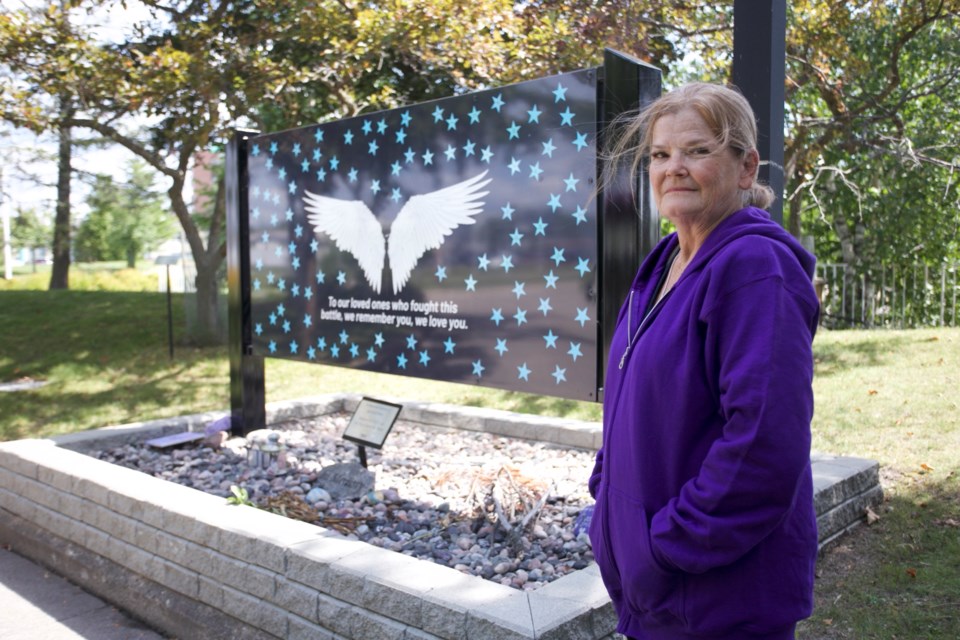The annual opioid death rate for the local health unit remains practically the same when compared to the previous year — and continues to be more than double the provincial average.
The most recent Q1 statistics released earlier this month by the Office of the Chief Coroner shows Algoma Public Health (APH) had the second-highest opioid toxicity mortality rate in the province between April 2022 and March 2023, when compared to the same period one year prior.
“I’m getting fed up. I am,” said Connie Raynor-Elliott, founder of the grassroots street-level organization SOYA, which assists people living with addiction. “In the last month I attended four funerals and celebrations of life and they all died of overdose. Every one of them.“
Currently, the death rate in Algoma is 50 per 100,000 people, virtually unchanged from the year before (51 deaths per 100,000).
SOYA oversees the Memorial Wall on the front lawn of the Ronald A. Irwin Civic Centre. The nameless statistics released by the Office of the Chief Coroner become less abstract every time new names are added to the stars on the wall.
“This side is almost full,” said Raynor-Elliott, standing in front of the memorial on Monday.
Raynor-Elliott said construction delays for the Northway Wellness Centre and Dennis Street Youth Hub, as well as other projects not yet underway, are contributing to the stagnant numbers.
“It was supposed to be already open, it’s not on track,” said Raynor-Elliott of the Northway Wellness Centre. “Nothing is on track, they bump it back and say it’s on track again. It doesn’t work that way.”
The estimated $20-million project in the former Sault Star building on Old Garden River Road was announced in spring of 2022, with an original completion date of December of that same year.
“I get it, there’s supply issues and everything. I get it. But come on, this has been dragging on for years,” said Raynor-Elliott. “People need to stop using the supply chain and COVID and all these other excuses because you can go sit with a mom who just lost her kid.”
The Community Resource Centre and men’s shelter in the former Sacred Heart School is also nearing completion.
At the same time, plans for a municipal taxpayer-funded safe consumption site have not yet been presented to Sault Ste. Marie City Council.
“And where’s our Day Treatment Program?” said Raynor-Elliott. “They expect me to literally jump up and down and say: 'Yay, this is happening.' But until those ribbons are cut and those doors are open it means nothing to me.”
In the meantime, the city is continuing construction on its almost $11.6-million public square on Queen Street East and will be spending almost $300,000 to put doors and locks around stairwells at the GFL Memorial Gardens.
APH is tied for second worst in the province with the Sudbury and District Health Unit in the most recent quarterly stats. Only the Thunder Bay District Health Unit has a worse result at about 53 deaths per 100,000 people.
Although the local stats are relatively stagnant versus the previous year, Mayor Matthew Shoemaker said he sees hope in the results seen in Timmins since that city opened its safe consumption site last year.
The Porcupine Health Unit, which includes Timmins, is now fourth-worst in opioid toxicity mortality rate rate behind the Thunder Bay, Algoma and Sudbury health units.
“Whether it’s that service specifically or that service in combination with additional mental health and addiction services that are available in the community do seem to be turning the trend in the right direction for them,” said Shoemaker.
Although the Porcupine Health Unit has fallen to fourth-worst in the province, its opioid toxicity mortality rate actually increased slightly last year versus the year before.
Although the opioid toxicity mortality rate didn’t improve in the Algoma Public Health unit, Shoemaker said it’s encouraging that it didn’t continue worsen.
“That shows some hope because to be honest there were reports that seemed to show no end to the trend of continued growth and overdoses and hospitalizations and deaths from opioid use,” said Shoemaker. “I think there is perhaps a roadmap to a better place but we are clearly not there yet. I hope this shows there can be progress on the file.”
Shoemaker agrees with Raynor-Elliott on at least one key service that needs to return.
“We need the return of the Concurrent Disorders Day Treatment Program," said Shoemaker. "I think that is a critical part the equation and in my view the consumption and treatment services is part of that equation as well."
Overdose Awareness Day will be marked Aug. 31 with an evening event organized by SOYA at the Roberta Bondar Pavilion.
